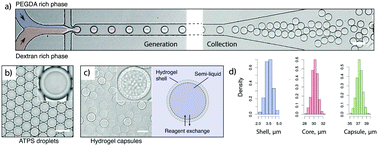Multi-step processing of single cells using semi-permeable capsules†
Abstract
Droplet microfluidics technology provides a powerful approach to isolate and process millions of single cells simultaneously. Despite many exciting applications that have emerged based on this technology, workflows based on multi-step operations, including molecular biology and cell-based phenotypic screening assays, cannot be easily adapted to droplet format. Here, we present a microfluidics-based technique to isolate single cells, or biological samples, into semi-permeable hydrogel capsules and perform multi-step biological workflows on thousands to millions of individual cells simultaneously. The biochemical reactions are performed by changing the aqueous buffer surrounding the capsules, without needing sophisticated equipment. The semi-permeable nature of the capsules' shell retains large encapsulated biomolecules (such as genome) while allowing smaller molecules (such as proteins) to passively diffuse. In contrast to conventional hydrogel bead assays, the approach presented here improves bacterial cell retention during multi-step procedures as well as the efficiency of biochemical reactions. We showcase two examples of capsule use for single genome amplification of bacteria, and expansion of individual clones into isogenic microcolonies for later screening for biodegradable plastic production.



 Please wait while we load your content...
Please wait while we load your content...